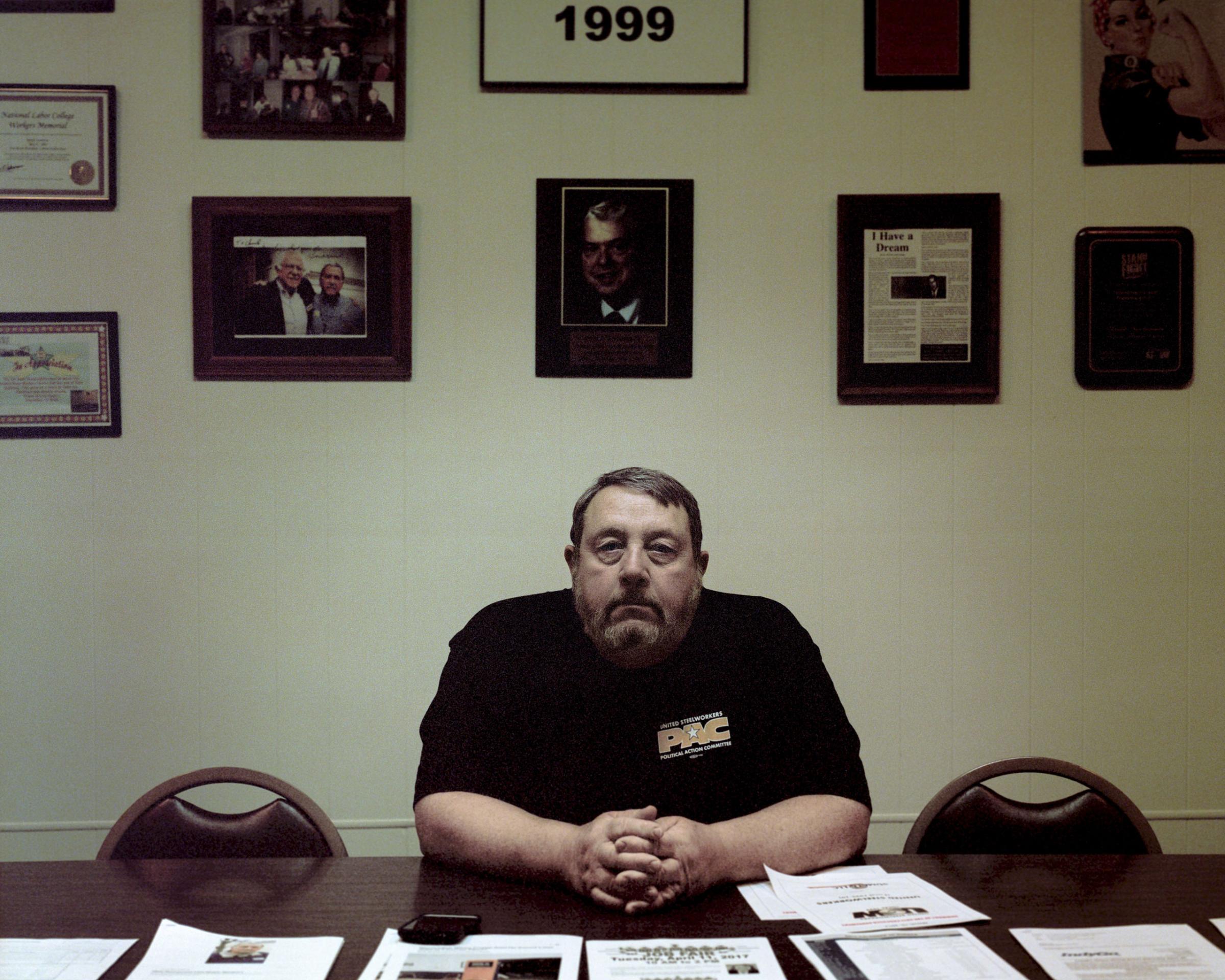
Deep bags sag under Brian Bousum’s eyes as he sips whiskey and water in a friend’s apartment on a recent Sunday evening. Fifty-one years old, he has spent the past two decades operating screw machines and setting up drill presses at the Rexnord ball-bearing plant on the west side of Indianapolis, a mile from the Carrier factory made famous by President Trump.
For a guy who didn’t go to college, he says, the work is hard to beat: the union offered job security and enough overtime to make up to $75,000 a year, a salary that enabled him to buy his own home with an in-ground pool. Bousum’s son joined him at the plant after graduating from high school.
By the end of the summer, however, they’ll both be out of a job. Rexnord, a $1.9 billion company based in Milwaukee, is closing the Indianapolis plant and moving its operations to Mexico. There, labor costs about $3 an hour, rather than the $25 Rexnord pays its longest-serving union employees in Indiana. The move will put more than 300 Americans out of work. Before that happens, some of the workers here are taking advantage of Rexnord’s offer of an extra $4 to $10 an hour to train their Mexican replacements. Others are too pained and too proud.
The outsourcing of America’s factory jobs is nothing new, of course. Since 1999, the nation’s manufacturing workforce has dropped 28%, from 17.3 million jobs to 12.4 million, as companies flee to countries with cheaper labor costs. Between 2001 and 2016, the U.S. had a net loss of nearly 54,000 manufacturing businesses. In those that remain, more and more work is being done by robots and advanced computers, which are usually overseen by engineers, programmers and others with at least four-year college degrees.
“This is a runaway train,” says Anthony Carnevale, director of the Georgetown University Center on Education and the Workforce. “In the end, technology and global markets improve productivity and benefit all of us. Sadly, it hurts some of us even more.”
Donald Trump promised to make the pain stop, and he owes his election in part to the Midwestern factory workers who believed he would make good on the pledge. “I absolutely got sucked into this message,” says Rexnord machinist Gary Canter, 46, who has started delivering pizza for Papa John’s three nights a week to sock away extra money before his impending layoff. For Bousum, the rationale was simple: “I voted for Trump based on the fact that he could save our jobs.”
They had reason to hope in early December, just weeks after Trump’s victory, when the President-elect announced a deal with nearby heating- and cooling-equipment manufacturer Carrier to keep 1,100 jobs in Indianapolis rather than move them to Mexico (although some 300 of those “saved” jobs were white collar positions that were never slated to move). The next day, Trump turned his ire toward Rexnord, which had already announced its relocation plan. “Rexnord of Indiana is moving to Mexico and rather viciously firing all of its 300 workers,” the President-elect tweeted. “This is happening all over our country. No more!”
More than five months later, Rexnord is pressing ahead with its move. Senator Joe Donnelly, a Democrat from Indiana, who has discussed the closure with the President, cautions that a last-minute reprieve is unlikely. “I don’t want to create false hope,” Donnelly tells TIME.
“This has been a very difficult decision and we understand its impact on our associates, their families and the Indianapolis community,” Rexnord said in a statement. But the company, which netted $68 million in the 2016 fiscal year, noted that “difficult decisions are a part of today’s business environment. To be a viable company that contributes to economic growth, we must meet customers’ needs with high-quality products at competitive prices.”
If Trump’s Carrier deal was a reminder of how the bully pulpit could be used to make the private sector bend, Rexnord’s closure shows its limits–and offers a lesson in the challenges of reversing a global economic trend decades in the making. When Trump tweeted about Rexnord again, on May 7, he said the deal to leave the country was made during his predecessor’s Administration, and alluded to levying “big” taxes on the Mexico-made goods the company will sell in the U.S.
But that will not revive an entire way of life in the Midwest–or address the host of knotty economic, social and political issues that come with its demise. “The blue collar life is all I’ve known,” Bousum says, drawing from his glass of whiskey. “How the hell am I going to survive?”

Every workplace has a third place, where colleagues go to celebrate a promotion, toast a retirement or simply blow off steam. For many at Carrier and Rexnord, that place is Sully’s, a sports bar across from the Carrier plant, where long-necks run $1 on special. Between shifts recently, TJ Bray and Kyle Beaman settled into a booth there to unwind. Beaman, 62, worked in quality control at Rexnord, while Bray, 33, started working at Carrier 15 years ago, one day before his high school graduation.
A year ago, Bray thought he would be the one out of a job. Carrier’s parent company, United Technologies (UTC), announced plans to close its Indianapolis plant and move its jobs to Monterrey, Mexico. Then Trump got involved. At campaign rallies, the candidate relentlessly hammered the company as a job killer, turning Carrier into a symbol of the devastation he said globalization had wreaked on the nation’s workers.
After Trump was elected, UTC, which has done billions of dollars in business with the Department of Defense, agreed to keep union jobs in Indianapolis in exchange for a tax-incentive package and, presumably, an end to the President’s barrage. “I am thankful to the President for what he did,” says Bray.
But even grateful workers worry that their paychecks may not survive future rounds of automation or cost cutting. Torrie Bennett, a 13-year plant veteran, says the mood at Carrier now “is like being in an ugly relationship. They’ve said they want to leave you. So you’re on guard.”
Trump’s intervention reinforced the expectation that he can prevent other companies from moving manufacturing jobs overseas. Asked what he would say to the President if he had the chance, Beaman, who worked his last day at Rexnord in April, is frank: “Can you help us? If you can’t help us, be man enough to tell us. A lot of people are banking on this. Donald Trump, can you save us?”
America’s manufacturing roots reach back almost to the dawn of the nation. Samuel Slater, a cotton spinner’s apprentice from England, opened what’s considered to be America’s first textile factory in Pawtucket, R.I., in 1790. Nine children pushed foot treadles to make spindles of yarn. From that tiny operation grew tens of thousands of factories making everything from the cement lining the Erie Canal to the tracks for the transcontinental railroad to the assembly-line Model Ts that ushered in the automobile age.
By 1943, in the midst of World War II, nearly 4 in 10 of America’s nonagricultural workers were employed in manufacturing, producing steel, ships and aircraft for the U.S. war effort; later, such workers produced homes, cars and air conditioners for the ascendant postwar middle class. The jobs were often steady and unionized, the pay good, and the requirements rarely more than a high school diploma and a solid work ethic.

But all that started to die in the early 1980s. Some 19.5 million Americans held manufacturing jobs in 1979, an all-time high. By 1983, the figure was already down to about 16.7 million. By 2024, according to projections from the Bureau of Labor Statistics, just 7.1% of Americans will work in manufacturing.
The reasons are many, but the prime culprits are globalization and automation. In 1991, China accounted for 2.3% of the world’s manufacturing exports. In 2001, the country joined the World Trade Organization, and by 2013, China’s share of global exports was 18.8%, according to a 2016 study in the Annual Review of Economics. Countries such as Mexico and the Philippines have also increased their exports. Labor in these markets tends to be substantially cheaper than in the U.S., and trade deals like NAFTA make it easy for American companies to produce goods in far-flung locales.
To economists, however, America’s shrinking manufacturing jobs have less to do with free trade than with robots. The U.S. still produces world-class airplanes, car parts and heavy machinery. Companies just need fewer people to make them. The result, according to the Brookings Institution, is that whereas it took 25 jobs to generate $1 million in manufacturing output in 1980, today it takes just 6.5 jobs. Many of the nation’s factories are more productive than ever, and there is growing demand for workers in so-called advanced manufacturing roles. From 2013 to 2015, 132,000 such jobs were added, according to Brookings.
But these positions increasingly require specialized technical training after high school, with preference often going to those with degrees in science, technology, engineering and math. And the work will be less about fitting pieces together manually than overseeing the robots that do it. Today, according to research from the Boston Consulting Group, robots perform about 10% of manufacturing work around the world. By 2025, they are projected to account for about 25%. “High-skill workers in factories will be managing processes,” says David Autor, a professor of economics at the Massachusetts Institute of Technology (MIT), “rather than showing off manual dexterity.”
Autor’s research shows that American workers who lost their manufacturing jobs as a result of trade shocks, like competition from Chinese imports, are likely to make less money and collect more disability benefits over the ensuing decade. He predicts a similar fate for the women and men at Rexnord. “Unless they get very lucky, there won’t be another employer out there saying, ‘Great, I can use a few more ball-bearings guys,'” says Autor.
Even the rescued Carrier jobs may be vulnerable. In an interview about the deal with CNBC in December, UTC chairman and CEO Greg Hayes said a $16 million investment to automate tasks in the plant would ultimately reduce the workforce. And the company is moving ahead with the closure of another plant in Huntington, Ind., which workers had hoped would be included in the Trump deal. When it shutters by early next year, some 700 people will be laid off. “There’s no easy way out of this,” says Georgetown’s Carnevale, who served on national workplace commissions under Presidents Reagan, Clinton and George W. Bush.
So far, the Trump Administration’s most notable move on trade has been pulling the U.S. out of the Trans-Pacific Partnership, the 2016 free-trade agreement among a dozen countries including Australia and Japan. The President also rolled back Obama-era environmental and workplace safety reporting regulations in the name of spurring job growth. In addition, he has appointed a number of business-friendly Cabinet Secretaries.
But after pledging to put an end to the nation’s economic carnage, Trump has softened some of his most aggressive stances on trade. The President no longer publicly calls China a currency manipulator, a sign that he recognizes the value of the strategic relationship between the world’s two largest economies. And after consulting with the leaders of Canada and Mexico, he has agreed not to terminate NAFTA, though he does want to renegotiate the sweeping trade agreement among the three nations that has been in place since 1994. Nor, despite his Rexnord tweet, has Trump backed including the border adjustment tax, a levy on domestic sales and imports favored by House Speaker Paul Ryan, as part of the GOP tax-reform effort.
Nevertheless, manufacturers see cause for optimism. The U.S. economy has added some 41,000 manufacturing jobs since February, and large firms such as GM and Hyundai have announced new investments in U.S. factories–often with the White House’s encouragement. Thanks in part to regulatory changes and proposed tax cuts, the National Association of Manufacturers (NAM) says 93% of member companies it surveyed have a positive outlook on the economy–a 20-year high. “What manufacturers see is an agenda from the federal level that is focused on growth,” says Jay Timmons, NAM’s president and CEO.
Many economists are far more skeptical. They say the nature of manufacturing work has fundamentally changed and they don’t believe tax cuts and protectionism can deliver a Rust Belt revival. “Those are not the policy solutions of the future,” says John Van Reenen, a professor of applied economics at MIT. Pointing to the U.S. trade wars of the 1930s that worsened the Great Depression, he says, “Those are the policy failures of the past.”
The trend lines are apparent in a Congressional Research Service report released in early May, which shows that the number of manufacturing workers with graduate degrees increased 35% between 2000 and 2016, while the percentage of workers with just a high school diploma fell by more than a third. “Even if increased manufacturing output leads to additional employment,” the report concludes, “it is likely to generate little of the routine production work historically performed by workers with lower education levels.”

At Rexnord, the layoffs have started to come in waves, every few weeks bringing news of more colleagues lost. “It’s like buying a ticket for the Titanic when you know the ending,” says Brian Reed, who has worked at the plant for 24 years. “You get up every day, and it’s just miserable.”
Rexnord is offering severance packages of one week’s pay for every year worked at the company. Employees who have worked there at least 15 years and whose age and years of service add up to 75 can start drawing on their pension as soon as they’re laid off. Everyone else has to hang on until they turn 65.
While they wait, the plant has been cleaved by the debate over training their replacements. John Leonard, 56, and Mark Elliott, 52, worked side by side for more than two decades, spending more time together than they did with their families. Elliott accepted the offer. Leonard thought they needed to refuse to help out with training as long-shot leverage to save their gigs. The friends stopped talking for two months as a result. “It’s all about the money,” Elliott says of his choice. The Mexican workers, he says, “didn’t steal those jobs.”
For others, it’s a matter of putting pride ahead of paying the mortgage. “It’s just a moral issue,” says Reed. “You’re helping the company that ripped the life from under you be successful.” As employee John Sullender explains it, “They’ve knocked us down as far as we can be knocked down. I have enough dignity–I’m not going to do that.”
Between sips of whiskey at his friend’s place, Brian Bousum takes the more diplomatic view. He turned down the training offer–but not because he couldn’t use the money. Bousum lost that nice house after his divorce, and after breaking up with his girlfriend he has temporarily become a middle-aged couch surfer. He will likely be laid off just months before being able to tap into his pension.
“How can you blame them for getting every damn dime out of the company they can get?” Bousum asks. And though he couldn’t bring himself to teach his replacement the skills he’s developed over more than 20 years, he knows this isn’t the Mexican workers’ fault. “It can’t be easy for them to be in a place where most people don’t care for them,” Bousum says.
What he’ll miss most about Rexnord is working alongside his son, taking a moment to pray together every day. There is some government money available for retraining, but Bousum is skeptical about his ability to transition as a middle-aged machinist with a high school diploma. Though for decades, that was good enough.
After voting twice for Barack Obama, Bousum pulled the lever for Trump. He liked that Trump was at least talking about reviving American manufacturing and restoring the middle class. Now, Bousum is praying for Trump to make good–even if he knows the faith may not be rewarded.
“I still have hope that something will change, something will happen,” Bousum says. “Donald Trump’s a millionaire. He doesn’t have to worry about hope and faith. But a blue collar guy like me, if you don’t have hope and faith, what do you got?”
More Must-Reads from TIME
- Why Biden Dropped Out
- Ukraine’s Plan to Survive Trump
- The Rise of a New Kind of Parenting Guru
- The Chaos and Commotion of the RNC in Photos
- Why We All Have a Stake in Twisters’ Success
- 8 Eating Habits That Actually Improve Your Sleep
- Welcome to the Noah Lyles Olympics
- Get Our Paris Olympics Newsletter in Your Inbox
Write to Sean Gregory / Indianapolis at sean.gregory@time.com